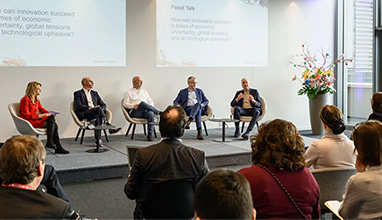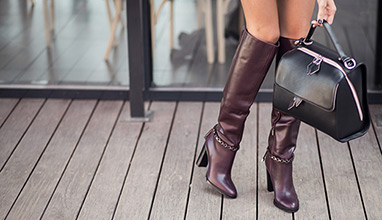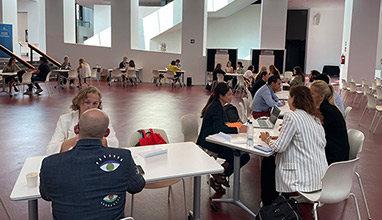Euratex presented the strategy for the future of the European textile and clothing industry
EURATEX plans to transform the crisis into an opportunity and become more digital, sustainable and agile. Endorsed by the last General Assembly, the renewal will be driven by the “strategy for recovery from the COVID-19 era” together with five flagship initiatives in critical areas. To guide the European textile and clothing industry towards its renaissance, the GA re-elected Alberto Paccanelli as President.
European textiles and clothing companies proved to be essential to managing the pandemic, as a great number converted to or increased the production of PPE. But this strategic role goes beyond the past events, as, without textile materials, no cars, clothes, machines or buildings can be built. The last months highlighted then the necessity for the whole sector and its value chain to undergo a renewal process and enter the future more competitive, sustainable and greener. The textile industry developed a recovery strategy.
EURATEX’s plan requires considerable resources and a coherent set of measures, both on short term and on a structural basis. While the European Commission and Member States already put in place some quick recovery moves, such as the re-opening of shops and companies and the guarantee of well-functioning markets and supply chains, it is now time to define the long-term vision. Europe should endorse the strategic importance of the European T&A sector, promote the development of an integrated ecosystem with the EU and its neighboring countries, invest on innovation and skills, and turn circularity into a source of competitiveness. The deployment of these durable measures must be now.

To make the strategy tangible and concrete, EURATEX developed five flagship initiatives:
- The impact of this type of crisis can be avoided by organising guaranteed supplies and building resilient value chains in Europe for critical PPE and other textile products.
- The textile and clothing workforce is growing older, as 35% of it is over 50 years old. SMEs should upskill their existing workforce to meet a rapidly transforming industry and attract well-qualified young workers and professionals.
- We should invest in innovative and sustainable textiles through dedicated Public Private Partnership (PPP) at EU level. These PPP will pool and accelerate research, innovation, pilot testing and demonstration in critical areas, like digital manufacturing and supply chains.
- EURATEX wants to establish 5 recycling hubs in Europe near textile and apparel districts and therefore make raw materials by collecting, sorting, processing and recycling post-production and post-consumption textile wastes.
- Goods blocked by national authorities at the borders should not happen in the future. It is fundamental to ensure free and fair trade for our companies. A first step should be to promote the Pan Euro Med as an integrated ecosystem, and exploit market opportunities resulting from other EU FTAs.
“This crisis showed the importance of our industry and now, more than ever, it’s essential to develop the competitiveness of the European ecosystem. The “EU Next Generation” package can play an important role and support the textile and clothing industry in its renaissance”, said Alberto Paccanelli, who was re-elected EURATEX President. The General Assembly also appointed EURATEX Vice- Presidents, Jean-François Gribomont, Gregory Marchant, Hadi Karasu and Bodo Bölzle.
The European Textiles and Apparel Industry in the Post Corona Era
Proposals for Recovery
Executive Summary
The corona crisis has confirmed the strategic importance of the European Textile and Apparel sector. The safety of healthcare workers and the population at large depend on textiles, but their importance goes far beyond. Without textile materials, no cars, airplanes or buildings can be built, nor can agri-food workers, first responders, defence and security forces or craftsmen, do their work in full.
This crisis is unprecedented and will have a lasting impact on our economy and society. EURATEX and its membership call for a strong partnership with the EU and for a strong coordination among member states, making sure the European Textile and Apparel industry emerges stronger out of the crisis than before, ready to support the European economy and to serve the European citizen. This will require considerable resources and a coherent set of measures, both short term and on a structural basis.
Quick recovery measures are essential to save the industry from massive closures:
1. effective short-term access to liquidity,
2. quick re-opening of shops and companies,
3. targeted public procurement,
4. well-functioning markets and supply chains
5. stop additional regulatory burden.
In the longer run:
6. a strong European Textile Alliance needs to be set up which can develop strategic value chains,
7. foster innovation, digitalisation and upskilling in the industry,
8. turn sustainability and circularity into a source of competitiveness,
9. ensure free and fair trade for our companies,
10. promote an integrated ecosystem with the EU’s long standing partners.
EURATEX commits to further develop the above proposals in cooperation with its members and the European authorities; each measure should have targets which can be monitored on its effective implementation.
1. The European Textiles and Apparel Industry
The textile and apparel (T&A) sector is an important part of the European manufacturing industry, playing a crucial role in the economy and social well-being in many regions of Europe. The sector includes ca. 170,000 companies (of which 90% are small companies), employing 1.7 million people and generating a turnover of nearly €180 billion. The sector generates €50 billion of annual export income for the EU.
The textile and clothing industry covers a range of activities from the transformation of natural (cotton, flax, wool, etc.) or man-made (polyester, polyamide, cellulosic etc.) fibres into yarns and fabrics, to the production of a wide variety of products such as hi-tech synthetic yarns, bed-linens, industrial filters, and clothing and fashion.
The sector has been subject to a series of radical transformations over recent decades, due to a combination of technological changes, the evolution of production costs, the emergence of important international competitors. Companies have improved their competitiveness by reducing or ceasing the mass production of simple products, and concentrating instead on a wider variety of products with higher value-added.
Today, European producers are world leaders in markets for technical/industrial textiles including non-wovens (industrial filters, hygiene products, products for the automotive and medical sectors, etc.), as well as for high-quality garments and interior textiles with a high design content.
2. Impact of the corona pandemic
Recent Eurostat data show that the European textile and clothing manufacturing went through a difficult year in 2019, despite good retail sales and export performances. Employment declined by over 2%, and the EU27 turnover evolution turned negative for the first time since 2012-2013 with a -2% setback for textiles, and a -1.3% for clothing, compared to 2018.
In March 2020, the EU industry confidence indicator for the months ahead fell dramatically in the textile & clothing industry, due to the Corona virus impact. According to the survey, the indicator for the months ahead decreased significantly in textile (by -6.7 points), reflecting managers’ crashing production expectations. Also the assessment of the current level of overall order books deteriorated. A simulation forecasts a loss in turnover for the entire sector of €50 billion in 2020.
This trend was confirmed in a EURATEX survey, carried out between 15 March and 15 April 2020:
• Over 60% of companies expect sales to drop by more than half (and 3 out of 10 companies expect a drop in sales of even 80% or more).
• 7 out of 10 companies face serious financial difficulties
• 8 out of 10 companies are reducing (at least temporarily) its workforce, thus putting hundred thousands of jobs at stake.
The impact of the corona crisis is aggravated by the specific characteristics of the T&A sector:
• T&A companies are operating in a globalised and competitive market, putting pressure on prices and margins. This has an impact on the financial strength of many companies, leaving little buffers for such a crisis, and resulting in low ratings with the financial sector, which in turn complicate access to finance.
• Most companies operate in complex value chains, making them dependent on external supplies, which can be easily disrupted. Both extra-EU and intra EU Single Market shipments have been disrupted by trade stops, national border controls or rolling production shut downs, thus creating important sourcing problems.
• Specifically in the fashion industry, sales are very time-sensitive; a “Summer season” cannot be postponed or recovered; it is simply lost.
• Production stops of technical/ industrial textiles do impact on other industries as medicals, agri-food, transport, etc. exposing domino effects for EU wide manufacturing.
• The entire industry was already going through important changes to tackle environmental, digital and skills challenges: making investments to reduce use of resources, increase circularity, digitise business operations and reskill/upskill the workforce. While necessary for long-term competitiveness, these investments impact on their short-term financial capacity.
• The T&A sector is heavily dominated by small business: nearly 90% of companies employ less than 10 people. Their capacity to absorb any extended period of production disruption or lack of end market sales is minimal.
3. Recovery Measures
The corona pandemic calls for extra-ordinary measures to safeguard the European T&A sector. A difference should be made between:
• short term measures, whose objective must be to support the survival of companies in the next 6 months; quick implementation is essential to avoid permanent damages.
• long term measures, whose objective must be to maintain and strengthen the critical European production value chains and their global competitiveness.
Short Term measures
a. Inject liquidity in the sector
To avoid company bankruptcies, companies need access to finance. In the short term, to finance stocks and operating costs; in the medium term, to develop their working capital; and in the longer term, to invest in innovation and digitalisation.
Several support schemes have been installed, e.g. the “SURE” initiative (€100 bln) to support flexibility in the labour market, the Corona Response Investment Initiative (€38 bln) or the European Investment Fund releasing €8 bln to provide liquidity to SMEs. However, it appears that such schemes are not always known by SMEs and difficult to access through the local banks, especially for textile companies, which often have low ratings.
Therefore, the Commission should urgently release guarantees to Member States loan schemes, only if they guarantee that SMEs are effectively benefitting from these schemes. EURATEX and its members will closely monitor the actual release of liquidity and impact on the sector and its supply chain.
Alternatively, EURATEX proposes a dedicated scheme offering, within 30 days loans to companies in the T&A industry at minimal interest rate, with a 10 year duration and grace period for the first year. The European Investment Bank / European Investment Fund could play an important role in this regard.
b. Stimulate the demand for T&A products
The quicker sales can pick up, the more limited the damage will be. EURATEX therefore calls for a relaunch of the economy as quickly as possible: shops should open whenever possible, companies should get back to work. This relaunch must be coordinated at European level, to avoid disruption of the single market.
Of course, such a relaunch should be in full respect of the health and sanitary measures that are necessary to avoid a new outbreak of the contamination. Community masks can complement social distance allowing safer opening of shops and return to the job. Authorities should support the costs of such measures as much as possible.
The current crisis should also lead to a reflection on consumer behaviour and more sustainable practices in B2B (e.g. fairs) and B2C (e.g. shops). A study on the presence/survival of the virus on T&A products would be useful to understand how to manage “safe” supplies in the longer run. EURATEX also calls for solidarity within the value chain: commitments should be honoured as much as possible, thus safeguarding long term partnerships between producers and retailers.
Furthermore, demand can be stimulated by a pro-active procurement policy1 of the EU and its member states, regional and local authorities, as well as accelerated payment of outstanding procurement orders.
Procurement of textiles goods and services which value sustainability criteria over price-only criteria and in coordination with the industry can support European business, while pursuing the Green Deal goals.
c. Maintain fluid and open markets
EURATEX is concerned about the pressure on the functioning of the internal market, which is essential to ensure a smooth flow of critical supplies. Border controls within the EU have increased sharply, leading to delays in supplies but also cancelling of orders, thus aggravating the economic impact of the crisis.
We therefore call on all member states to ensure a more coordinated and coherent approach to avoid limitations to the free movement of goods and of the workforce, needed to maintain production as much as possible.
On average, public procurement accounted for 13.1 % of GDP in 2015 in the EU22, equal to almost €1.923 Billions spent by public bodies purchasing goods or services. Source: EURATEX “Prospering in the Circular Economy 2020” and European Parliament “Green Public procurement […] 2017”
We also call for an unequivocal commitment by the EU’s leaders that, wherever possible, industrial production and related operations must be maintained throughout the corona crisis. To reduce the long term impact of the crisis, it is vital to prevent industry shutdowns today, of course while respecting the crisis management measures issued by governments.
At international level, the EU and its trading partners should refrain from imposing export and import restrictions (e.g. regulation on export authorisation for protective masks) or other barriers (e.g. stockpiling requirements) that will disrupt already stretched global supply chains, both within outside the EU. The EU should be particularly careful while implementing exports/imports restrictions as it may encourage future retaliations from its global trade partners and will definitely disrupt strategic supply chains in the textile and clothing sector.
Moreover, it is of upmost importance to enhance flexibility through customs authorities accepting electronic documents (e.g. proof of preferential origin) and to encourage ongoing dialogues with trading partners, like the US and China.
d. Avoid creating additional burdens during the crisis
The European legislator should be extremely prudent to introduce new measures that would – directly or indirectly – increase costs and regulatory burdens on companies and authorities during the current crisis.
Specifically, the T&A sector is subject to a new range of restrictive measures which affect both public and private stakeholders. These include: updating the EU POP regulation with PFOA chemicals, several consultations on PFAS2 chemicals, the new SCIP database of the EU Agency ECHA, the BREF review, the application of the CMR textile restriction under REACH, the national transpositions of the Waste Directive (EU) 2018/851.
The above listed actions shall be put on hold for a period of 6-12 months as appropriate.
Additionally, the timing of new policy making processes on the wide Green Deal, specific actions for Circular Economy, mandatory due diligence and un-intentional microplastics release should be planned prioritizing only recovery-boost measures.
Long term measures
e. Confirm the strategic importance of the European T&A sector
The current enormous need for protective equipment illustrates in a painful way how much the safety of healthcare workers and the population at large depend on textiles. But their importance goes far beyond. Without textile materials, no cars, machines or buildings can be built, nor can agro-food workers, doctors, defence and security forces or craftsmen, do their work in full.
2 e.g. ECHA public consultation on PFHxA, Commission study on PFAS use in texitles,
It is time therefore to recognise the T&A sector as an essential and strategic part of the European economy. This should translate into the adoption of an EU strategy for the T&A sector, the development of dedicated programmes to support its competitiveness and the creation of an effective alliance where dialogue between the public and private sector can be organised.
EURATEX also proposes to conduct a study on strategic production value chains of specific T&A products in Europe (including access to raw materials and chemical products), how they are currently organised and can be secured in the future.
The current crisis also illustrates the need to enhance further investments and research in crucial industrial sectors in Europe, as it is the case of Textiles and Clothing. Dedicated research and production clusters on PPE could be established across the EU and its neighbouring countries, which can accommodate companies with the necessary research and/or production capacities.
Such initiatives should be embedded in the new EU Industrial Strategy by fostering EU innovation and production.
f. Promote innovation, digitalisation and upskilling in the T&A industry
Significant advances in productivity, flexibility and sustainability of EU textile and apparel manufacturing can be realised through technological innovation and digitalisation of production processes and supply chains. Investment in material and product innovation is needed to sustain Europe’s leadership in technical textiles and ensure a pole position in future markets such as smart textiles/wearables or advanced bio-based textiles.
European research and innovation funds should be harnessed in a coordinated and strategic way in the form of a Public-Private Partnership for Circular, Bio-based, Smart Digitised Textiles, building on the established European Textile Technology Platform and leveraging EU research and innovation, regional funds through the S3 thematic partnership on textile innovation and private funds for a total investment of € 1 billion between 2021-2027.
Long-term workforce development efforts of the industry must be supported through regional investments in the modernisation of the textile VET infrastructure. EU level best practice actions following the lead of the S4TCLF Blueprint project must be supported through the ERASMUS+ programme. Large-scale reskilling and upskilling initiatives and initiatives to facilitate integration of lowly skilled workers, unemployed or migrants into the T&A industry workforce should be supported by the European Social Fund and other suitable support instruments. Specific efforts are needed to attract the young generation to the T&A sector.
g. Turn sustainability and circularity into an opportunity and a source of long term competitiveness
Pursuing the common goals set by the Green Deal, the industry and authorities must coordinate actions to reward and foster changes across the textile value chains. The commitment and engagement shown by the European textile and apparel industry for sustainable and circular textiles should guide the EU action for recovery and industry re-build.
EURATEX welcomes the ambitions set forward by the EU Commission, Parliament and Member States to use3 the recovery as on opportunity to build a sustainable, stronger European Industry.
In the case of Circularity, EURATEX has already set forward 38 specific action proposals on: better products’ design, procurement, partnerships, recycling, implementation of EU Waste Directive, new markets, traceability and engagement of consumers.
These proposals contribute to the EU Textile Strategy planned for 2021, but they can also inspire industrial policy designed to re-lunch the economy. This would enable boosting sustainability, competitiveness of European companies and job creation in the European Union, including reshoring of certain key phases of production in the various T&A value chains.
h. Improve the “level playing field” on domestic and international markets
The current crisis leads to intense discussions on the value and benefits of globalization. EURATEX maintains its support for open EU and extra-EU markets, based on free but fair competition.
It is clear that Europe’s competitiveness is based on quality, innovation and sustainability, more than on price. Recent export figures confirm that European companies are increasingly successful on global markets.
Moreover, the European T&A industry is an important employer in developing countries. If domestic demand and consumption of textile and fashion products come to a standstill for a long time, it will inevitably also have a negative impact on the entire textile supply chain, which may be hard to re-establish once broken. The first cancellations of orders have already led to massive factory closures, piles of stocks and redundancies in certain partner countries. This can jeopardise their stability in a way that would impact the EU economy in the medium and long term.
For the European T&A industry to maintain this important role on the global market, unfair competition, including dumping practices, must be eradicated. That implies equal conditions and respect of environmental and social standards and avoiding unfair state aid. Effective compliance controls are necessary, as the cases of unfit protective masks in hospitals and the market has shown again.
A new fit-for-purpose Market Surveillance system must be created in cooperation with EU, Member State and the business. This shall guarantee more effective controls on non-compliant products by national customs and accredited laboratories. Sufficient resources should be earmarked to guarantee sufficient testing capacity, covering the (growing) regulatory norms which are established.
When negotiating FTAs or revising the GSP rules, the EU should consider the strategic interest of the European T&A sector, and not sacrifice it in a trade off with other industries.
Also, textile products should not be listed in retaliatory or rebalancing measures which the EU wishes to engage in in response to trade disputes with third countries.
Concerted efforts at European level are necessary to promote European products in our export markets, especially in the context of free trade agreements negotiated by the EU; international trade fairs can play an important role in this regard.
e.g. Statements from European Council and European Commission April; call for a green recovery global alliance 14th April
i. Promote the development of an integrated ecosystem with the EU and its neighbour countries
Since 1996 already, EURATEX has promoted the development of the greater PanEuroMed region (including EU, UK, Turkey, EFTA and North African countries) as an integrated ecosystem for the T&A industry. This integration allows to increase proximity of production, which in turn offers advantages in terms of time and flexibility, and reduces the environmental and social impact of the industry (e.g. transport, due diligence). The current crisis should accelerate this integration process.
EU’s trade in textiles and clothing with Turkey is by far the most voluminous4 in the Euro-Med region and therefore vital for healthy integration in the region. In order to ensure fair competition for all, it is of utmost importance that the negotiations on upgrading the EU-Turkey Customs Union resume immediately, to ensure full integration of the Turkish T&A sector.
Also the adoption and speedy implementation of the so-called Pan EuroMed Convention on rules of origin is an essential instrument to facilitate that integration process. Further action should be developed to promote the effective use of this agreement, both in the EU and South Mediterranean countries and facilitate cooperation between different players of the value chain, within this region.
Such agreement should also include the UK; it is the easiest way to ensure a seamless transition to their status as ”3rd country”, while maintaining the strong economic links between the EU and the UK.
Further Information:
Dirk Vantyghem, Director General EURATEX
Dirk.vantyghem@euratex.eu
“Statistics – Trade - European Commission.” European Commission Directorate - General for Trade. Retrieved 22 April 2020:
https://www.ec.europa.eu/trade/policy/countries-and-regions/statistics/regions/
Hits: 12535 | Leave a comment
Tags:Euratex, clothing industry, strategy


















